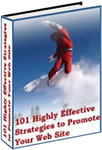How to
Design a Search Engine Friendly Web Site
© Herman Drost
Many web site designers don't design their sites for the
search engines. This is a huge mistake because they miss
out on attracting lots of free traffic. Your beautifully
designed web site may have cost you thousands of dollars
but it still needs to attract visitors to be profitable.
Here are 12
highly effective strategies for designing a
search engine friendly web site:
1. Research highly targeted keywords
- do this even before
you begin designing otherwise you may have to go back and
clean up some of your web site design. Use the keyword
research tool,
Wordtracker to research the most popular
keywords that pertain to the subject matter of your web
site.
Wordtracker will show how many people have searched for
that particular keyword over several search engines within
the last 60 days.
2. Create a list of approximately 100 keywords
or keyword
phrases that you can include within your web pages. After
having completed the above research, you should have found
the keywords that were searched on most frequently, but
only produce a small number of competing web sites.
3. Write a paragraph of 250 - 500 words of text
for the top
of each web page. Weave your keywords within this text
being careful not have them so close together that your
copy reads strange for your visitors. Aim to please the
search engines as well as your web site visitors.
4. Optimize meta tags
- the most significant meta tags are
the title and description meta tags. The keyword meta tag
has lost its effectiveness due to people spamming it,
however include it anyway as some search engines still use
it. Include your keywords within each of these meta tags.
The title meta tag should be a short sentence about the
purpose of your site. In your description meta tag, write
a sentence on the greatest benefit of your site. Your
keyword meta tag should include the most frequently used
keywords contained within your web page.
5. Include Header Tags
- these can range form H1-H6
most designers will only use H1-H3. These tags separate
each section of your web page with subheadings. The H1
tag contains the largest font and is the most significant.
Within the descriptive text of these header tags you
should
include the keyword phrases placed in the same order as
your keyword phrases that are within your keyword meta
tags.
6. Optimize images using the alt tag
- write a short
description for the alt tag of your image. The alt tag has
2 purposes:
a) visitors can read the description if they can't see the
image.
b) search engines only spider text (not images), therefore
this
could help your site's rankings.
7. Reduce image size
- too many images or very large images
on your web page will slow down the loading time of your
web site. Make sure your images have a resolution of
72ppi.
Slice large images into smaller pieces with your graphics
editor.
8. Find incoming links
(backward links) - web sites that
link to yours raise your link popularity. Search for web
sites that are compatible with yours and have a PR 4 or
more
to do a link exchange. Write optimized articles and
include
them on your web site. This means your site has a greater
chance of being indexed quickly as well as getting a boost
in its rankings.
Create absolute links (ie http://www.domainname.com)
from all your internal pages to your home page. This will
increase the number of links pointing to your home page.
9. Use Cascading Style Sheets
(CSS) to implement a clean
design throughout your web site. This will reduce the time
to implement a consistent text (or layout) style for your
web site. It will also enable you to easily update your
whole site should you wish to make any future changes.
10. Place any script code into external files
- when using
javascript (ie for swapping images on your navigation bar)
it creates a lot of code between the header tags, pushing
down the text that search, engines would spider first.
Placing the script code in an external file reduces the
code to just one line.
11. Insert the DOC TYPE tag at the top of every web
page.
A DOCTYPE ( “document type declaration”) informs the
validator which version of HTML you’re using for your web
pages. DOCTYPEs are a key component of compliant web
pages:
your markup and CSS won’t validate without them. i.e.
[!DOCTYPE HTML PUBLIC "-//W3C//DTD HTML 4.01
Transitional//EN" "http://www.w3.org/TR/html4/loose.dtd"]
DOCTYPES are also essential to the proper rendering and
functioning of web documents in compliant browsers like
Mozilla, IE5/Mac, and IE6/Win.
12. Write clean html code
- web site editors often write
extra code. This can increase the loading time of your web
pages. Check your html code by running it through a html
validator.
Once you have implemented all the strategies above, submit
your site to the search engines and get ready for lots of
targeted traffic.
You now have built a profitable search engine friendly web
site.
Resources
The
Global Structure of an HTML Document
Page Validation and Loading Times
HTML Validator
|
Subscribe
FREE to
Marketing
Tips Newsletter
NEW
Ebook
101 Highly Effective
Strategies to Promote Your Web Site

Hosting
from $30/year
|